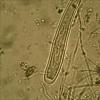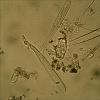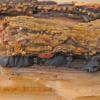
24-12-2025 17:08
Hulda Caroline HolteHello, I have found this propoloid ascomycete on

21-12-2025 09:32
Hello.A tiny ascomycete found embedded in wood in

21-12-2025 21:32
Pol DebaenstHello, Garden, Burgweg 19, Veurne, BelgiumOn 10/1

22-12-2025 23:38
Patrice TANCHAUDBonsoir, récolte sur un mur en pierre, apothéci

22-12-2025 00:47
Patrice TANCHAUDBonsoir, récolte à proximité du milieu dunaire
Orbilia
Joop van der Lee,
25-02-2017 19:24
 Found in a dune area on a rotten piece of branch probably hawthorn. Tkey only were visible under what was left of the bark. Fruitbody 1-2 mm, black, asci 75-90 um.
Found in a dune area on a rotten piece of branch probably hawthorn. Tkey only were visible under what was left of the bark. Fruitbody 1-2 mm, black, asci 75-90 um. The orange fruitbodies are probably orbilia.
In my opinion there are in total 3 different kind of ascomycetes present, some littel white ones in the lower right corner.
Peter Püwert,
25-02-2017 19:38
Re : Unkown asco?
Hi Joop,
Orbilia is recognized correctly, Zotto knows here definitely more. However, the black fungus is a completely other species, Durella, Patellaria.......
Greetings Peter
Edit:
Have you changed the text ?
Joop van der Lee,
25-02-2017 19:51

Re : Unkown asco?
Vielen dank Peter
Hans-Otto Baral,
25-02-2017 20:28

Re : Unkown asco?
Hi Joop
yes, it seems Patellaria and the asci are quite immature.
If you mount the Orbilia please take water and do not apply pressure.
Could be O. vinosa or various other species.
The white apos I cannot tell, maybe helotiaceous.
Zotto
yes, it seems Patellaria and the asci are quite immature.
If you mount the Orbilia please take water and do not apply pressure.
Could be O. vinosa or various other species.
The white apos I cannot tell, maybe helotiaceous.
Zotto




